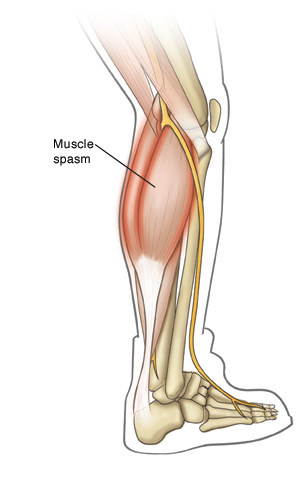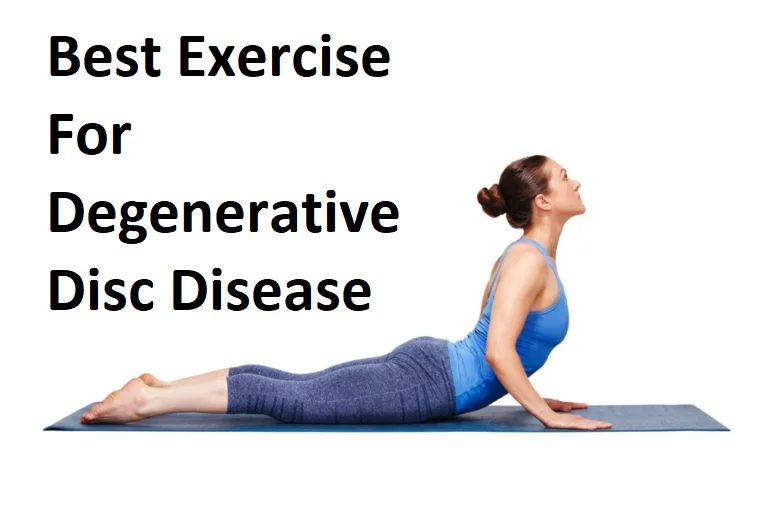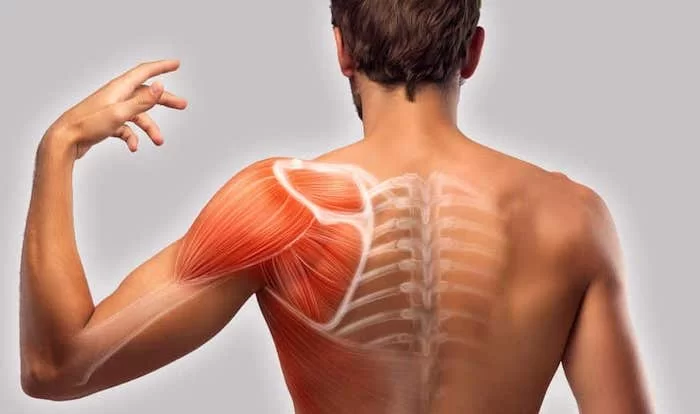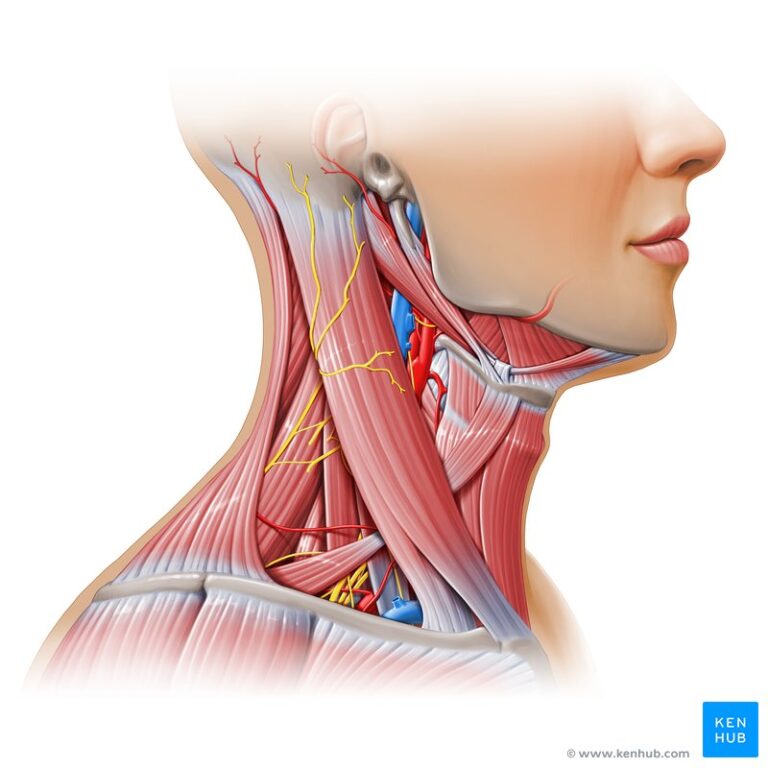Muscle spasm in the neck:
This neck muscle spasm occurs when your neck muscles become tightened. In this condition, your neck becomes too painful & stiff, affecting the ability to turn your head.
Stress-related muscle tension & and awkward neck movement is triggers of neck spasm.
This muscle spasm is produce intense pain &this pain stays last for minutes, hours & days then relax the muscle spasm.
This muscle spasm is released by to RICE principle, pain medication, massage & physiotherapy treatment.
Table of Contents
What are the causes of neck muscle spasms?
- Muscle spasm in the neck occurs during over-exercise.
- If you carry something heavy with one & both of your arms.
- When you place a lot of weight on one of your shoulder joints with a heavy bag
- If you are holding your neck in an unnatural position for an extended period like when sleeping in an odd position & when cradling a phone between your shoulder joint & ear.
- Other causes of muscle spasms:
- When you are feeling emotional stress.
- Due to your poor posture like slouching & head tilting.
- Sometimes dehydration, which is lead to muscle cramps & spasms.
- Some Less common but more serious causes which are produced by neck spasms include:
- Meningitis = is a very serious infection that is produced by swelling in the brain & spinal cord.
- Cervical spondylosis is a type of arthritis that affects the spine.
- Ankylosing spondylitis = in this condition occurs to vertebrae in the spine to fuse
- Spasmodic torticollis which is also known as cervical dystonia = happens when the neck muscles tighten involuntarily & make your head twisted to one side.
- Spinal stenosis = happens when occurs to open spaces in the spine with narrow
- Temporomandibular joint disorders which are also known as TMJs or TMDs = this condition is affecting the jaw & surrounding muscles
- If occur to trauma in the neck from accidents or falls.
What are the symptoms of the neck muscle spasm?
- In the neck, spasms occur to a sudden tightening of the neck muscles.
- When you feel severe & sharp pain.
- If occur to problems moving the neck & shoulder joints.
- When increased to pain when moving the neck & shoulder joint.
- You are feeling to headache.
- You feel dizziness & tingling at the base of the neck.
- The affected muscle also feels hard & tight.
- It is become too painful to move your neck around.
What are the types of neck muscle pain?
Neck spasms are produced neck muscle pain.
This pain is classified as chronic or acute pain.
- Acute pain:
- This muscle pain starts suddenly & a couple of days or weeks.
- Chronic & long-term pain:
- This muscle pain develops over a longer period and lasts for over 3 months is occur due to your activities & daily living & becomes too severe & leads to disability.
This neck muscle pain is also classified as axial or radicular neck pain.
- Axial neck pain:
- This muscle pain is mostly felt in the neck area.
- Radicular neck pain:
- This muscle pain is felt in the neck area & also shoots or radiates into other areas like the shoulder joint & arms.
How to Diagnose Muscle spasm in the neck?
It has become too challenging for any health care provider the cause neck muscle spasms.
- First, the doctor takes a full medical history.
- Sometimes physical examination & imaging scans of the lower back & spine is necessary.
- If the patient presents with other symptoms then the doctor is advised to explore whether & check whether the symptoms are related to the muscle spasms or not.
- Your doctor is also advised to X-ray for signs of arthritis & bone fracture.
- Also, advise an MRI or CT scan to gain a better look at the muscles & other soft tissues.
- These scans help to identify possible problems with the discs & with blood supply to the affected area.
In which condition do you need to contact a doctor as an emergency?
- Some causes of neck spasms are more serious than others causes so that need to contact your doctor when :
- If your neck spasm is the result of an injury & a fall.
- If due this spasm develop into numbness in your back, limbs & other body parts.
- When you feel trouble moving your limbs & lose control of your bladder or bowels
- If your symptoms become too difficult to sleep at night & take part in normal activities
- When your symptoms aren’t relieved after a week
- It is also an emergency when you feel symptoms of meningitis like a stiff neck & high fever over 100.0°F (37.8°C).
What is the treatment for neck muscle spasms?
RICE principle:

When you feel pain in the back muscle doctor is advised to RICE principle as home treatment or primary treatment.
- R – rest = When you feel muscle pain doctor is advice to you rest for sometimes form activities for release to muscle pain.
- I- ice = You Applied to ice on the area of the pan for 20 minutes, release swellings & muscle pain but always applied to the ice with the help of a towel between the skin & ice to prevent ice burn, you can also be used to ice pack & frozen peas for ice therapy.
- C- compression = You can also apply compression bandage release to muscle pain, and swelling.
- E- elevation = You must be elevated to the back with the help of a pillow under the foot for release of muscle pain & swellings.
Pain medication
- Over-the-counter drug means nonsteroidal anti-inflammatory drugs = NSAIDs like ibuprofen (Advil, Motrin) & naproxen (Aleve)which help to reduce inflammation & relieve the pain of the neck spasms.
- These medications do not treat the underlying problems which help to trigger your neck spasm, but this drug also provides quick-acting first aid that reduces pain.
- In some cases, the doctor is used to muscle relaxants drug.
- You can also take to steroid & anesthetic injections.
- You can also apply pain-relieving gel & spray like volini gel & spray on the area of muscle pain release to muscle pain & swellings.
Moist heat:
- You are applying moist heat to the affected area [ muscle spasm area ] which also helps with the recurring neck spasms.
- You apply moist heat to the spasm area using a heating pad or a damp & warm cloth.
Treatment of anxiety or stress:
When the muscle spasm occurs it occurs due to anxiety & stress so relaxation techniques are helping to ease your symptoms.
- Medication
- You are taking part in a session of yoga & tai chi
- Practice deep breathing exercises
- You must go for a walk
- You are taking a relaxing bath
- You are doing the massage or acupuncture treatment in the spasm area.
- It is normal to feel anxious sometimes for every people but when you frequently experience anxiety, stress & mood swings that lead to significant distress & interfere with your daily life & talk to your doctor.
What is Physiotherapy treatment for Muscle spasm in the neck?
When the muscle spasm is not relieved after the home treatment & pain medication then the doctor has advised physiotherapy treatment to release muscle spasms.
Physiotherapy treatment is help you relieve pain, swelling, muscle spam & tightness of the muscle pain.
The physiotherapy treatment includes massage, electrotherapy treatment & exercise therapy.
How to massage a neck spasm?
- Massage therapy helps you relax, which is help calm your tight muscles & ease the pain from your neck spasm.
- You are applied gentle pressure on the stiff & tender points which is help you release tension from the constricted muscles, providing relief & restoring range of motion – ROM to your neck.
- This massage therapy also increases blood flow to the neck, which is applied to speed up healing by starting the nutrients & oxygen to damaged muscles.
- In massage therapy, you apply firm pressure on the muscle spasm area which is help reduce tension & stop the spasm.
- You press on the affected area for 30–60 seconds then rub the surrounding area in a circular motion.
- Massage is applied after 2 – 3 days of following the RICE principle when you feel to release of the pain.
- Massage is applied with the help of the oil & applied for 5 -10 minutes.
- Massage is applied 3 times per day at home.
Electrotherapy treatment for Muscle spasm in the neck:
After the RICE principle, pain medication & massage if the muscle pain is not relieved then used Electrotherapy treatment for released to muscle pain.
To relive the swellings, spams & pain therapist is advised to you electrotherapy treatment.
In electrotherapy, the treatment therapist is used to many machines.
- When the trigger & tender points are present therapists are advised & to apply US = ultrasound therapy for the release of muscle pain.
- This treatment is applied with the help of gel & applies for 5 to 10 minutes on the area of pain.
- This therapy helps you release pain & swelling.
- Reduce to pain therapist is applied to SWD = short wave diathermy on the area of pain.
- SWD = Short wave diathermy is hot therapy for release to spams on the area of pain.
- This therapy is applied for 10 minutes to the area of pain.
Exercise therapy for neck muscles spasm :
After following the RICE principle for 2- 3 days at home & primary treatment & the help of pain medication, you feel released from the muscle spasm.
When you feel too comfortable & release from your muscle spasm then the physiotherapist is advised to you exercise therapy reduce to muscle weakness & tightness.
because when occurring muscle spasm also leads to muscle weakness & tightness so the need to exercise therapy strengthens the muscle.
The exercise therapy for muscle pain includes Stretching & strengthening Exercises.
Stretching exercise helps to relieve muscle tightness as well as strengthening Exercise is help you relieve muscle weakness.
Stretching exercise:
After the follow of Electrotherapy for 2-3 days for release to muscle spasm by physiotherapist then the therapist is advised to stretch for release to muscle tightness.
This stretching is applied when your pain is released & when you feel comfortable.
- Simple neck stretch
- Scalene stretch
- The basic neck stretch
- Side Tilt
- Side Rotation
- Seated twist
- corner Stretch
- Levator Scapulae Stretch
- Upper Trapezius Stretch
- Doorway Stretch
- Seated Clasped Neck Stretch
- Thread the Needle
Simple neck stretch:
- You are sitting & stand with your head looking forward.
- Then gently turn your head to the right.
- First, lightly place your right hand on the back of your head & allow the weight of your hand to push your chin down toward the right side of your chest.
- Relax your muscles & hold your head in this position for 30 seconds.
- Repeat this stretching exercise 3 times on each side.
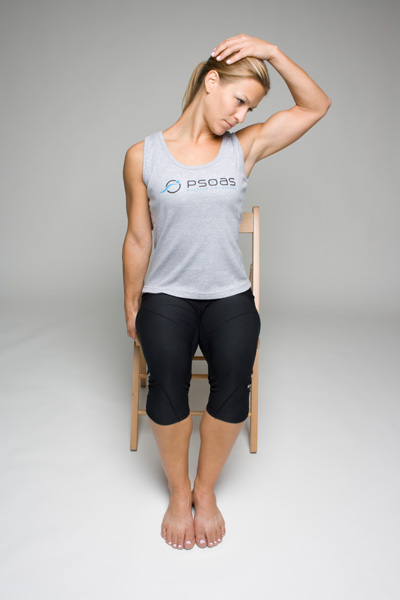
Scalene stretch:
- You are sitting or standing with your arms & hanging down at your side.
- Try to reach your hands behind your back & grasp your left wrist joint with your right hand.
- Then gently pull your left arm down & tilt your head to the right side till you feel a slight stretch in your neck.
- Hold this stretching position for 15 to 30 seconds.
- Repeat this stretching exercise 3 times on each side.
The basic neck stretch:
- Perform this stretching in a sitting or standing position.
- First, place your right hand on the top of your head.
- Then pull your head down towards the right side of the chest
- Repeat this stretching on the left side.
- Hold this stretching position for 30 seconds.
- Perform the 3 times in 1 session & 3 sessions per day.
Side Tilt:
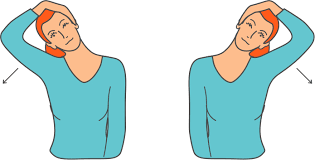
- Perform this exercise in a standing position.
- Then Gently tilt your head toward your right shoulder joint & try to touch your head with your ear.
- Stop this movement when you feel the stretch.
- Don’t raise your shoulder joint.
- Hold the stretching position for 30 seconds & return to the starting position.
- Perform the 3 times in 1 session & 3 sessions per day.
Side Rotation:
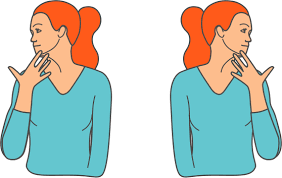
- Performs this exercise in standing & sitting positions.
- Must be Keep your head squarely over your shoulder joint & your back straight.
- Then slowly turn your head to the right till you feel a stretch in the side of your neck & shoulder joint.
- Hold the stretching position for 30 seconds & slowly turn your head forward again.
- Perform the 3 times in 1 session & 3 sessions per day.
Seated twist:

- You are sitting on a chair with a straight back.
- Put the left hand on the right knee joint & gently pull to rotate the shoulder joint to the right as if looking behind the chair.
- Then slowly return to the center.
- Repeat this stretching the twist with the right hand on the left knee joint.
- Hold this stretching position for 30 seconds.
- Perform the 3 times in 1 session & 3 sessions per day.
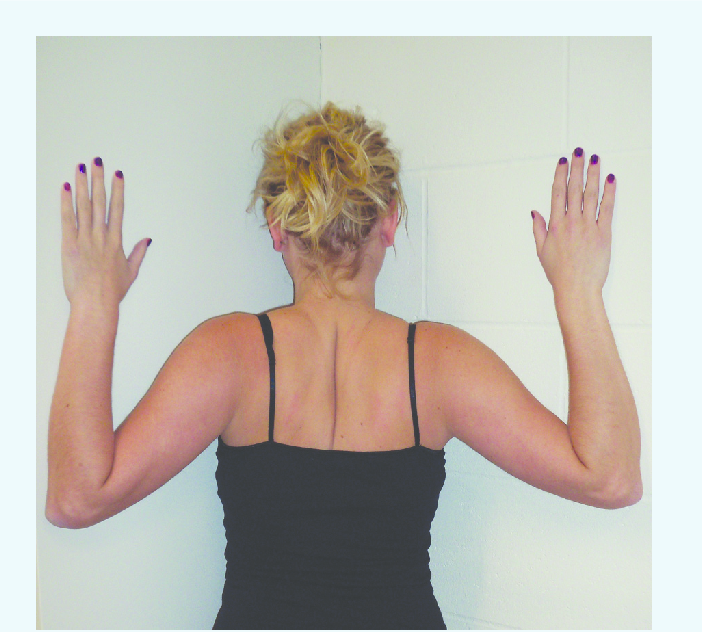
Corner Stretch:
- Start this exercise in a Standing position approximately two feet back from the corner & facing into the corner.
- Must be placed Feet should be together.
- Place the Forearms on each wall & elbow joint a little below shoulder joint height.
- Then Lean the body as far as possible without pain.
- You are feeling a stretch in the front of the shoulder joint & chest.
- Hold the stretching position for 30 seconds to 1 minute.
- Perform the 3 times in 1 session & 3 sessions per day.
Levator Scapulae Stretch:
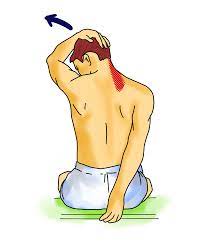
- Perform this exercise in standing & sitting positions.
- Then Lengthen the muscle by raising the elbow joint above the shoulder at the side to stretch.
- In this position, first, rest the elbow joint against a door jamb.
- This action rotates the outside of the shoulder blade up & the inside of it down, which is provided to lengthen the levator scapulae muscle.
- Next, turn the head away from the side which is given for stretching & bring the chin down.
- You feel stretching the back of the neck.
- Hold this stretching for about 30 seconds to 1 minute.
- Perform the 3 times in 1 session & 3 sessions per day.
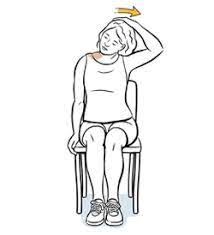
Upper Trapezius Stretch:
- You are in a Sitting position up tall with good posture and must keep your shoulders down.
- Try to grasp the bottom of the seat with one hand.
- Slightly turn your ear to your shoulder joint till a comfortable stretch is felt on the opposite side of the neck.
- Hold this stretching position for 30 seconds.
- Perform the 3 times in 1 session & 3 sessions per day.
Doorway Stretch:
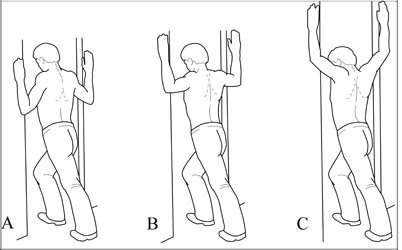
- You are standing in a doorway with your hands & arms out to the side as shown in the picture.
- Must be Keep the forearms flat on the door frame.
- Then take one step forward with one leg to feel a comfortable stretch in the chest region.
- Hold this exercise position for 30 seconds.
- Perform the 3 times in 1 session & 3 sessions per day.
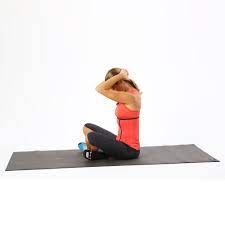
Seated Clasped Neck Stretch:
- You are sitting comfortably on the floor & in a chair.
- Must place your body in proper alignment.
- Then Clasp your hands & bring both palms to the back of your head.
- Try to Gently press your hands down toward your thighs & tucking your chin into your chest.
- Hold this stretching position for 30 seconds.
- Perform the 3 times in 1 session & 3 sessions per day.
Thread the Needle:
- Start this exercise on all fours with your hands under your shoulder joint & hip joint over your knee joint.
- Try to reach your right arm underneath & across your body with your palm facing up.
- Bend your left elbow joint as you gently lean into your right side.
- You are feeling a stretch in the back of your right shoulder joint.
- Hold this stretching position for 30 seconds.
- Perform the 3 times in 1 session & 3 sessions per day.
Strengthening Exercises:
After the follow of Electrotherapy & massage for 2 -3 days for release to muscle pain by physiotherapist then the therapist is advised to you strengthening exercise for release to muscle weakness.
This strengthening exercise is always advised when you feel to release pain & when you feel comfortable.
This all strengthening exercise helps to you muscle weakness & pain.
- Neck curl &head lift
- Forward & Backward Tilt
- Shoulder Roll
- Neck Flexion (Forward Bending)
- Lateral Neck Flexion (Bending Side to Side)
- Neck Rotation (Turning Side to Side)
- Wall Push Up
- Theraban Rows
- Prone Rows
- Behind the Back Drill
- Shoulder rolls
- Side bends
- Head lifts
- Lateral raises
- Anterior raises
- Seated overhead press
- Rows
Neck curl &head lift:
- You are lying down when you are about to do a sit-up.
- By placing your hands behind your head & tuck your neck into the chest
- Try to lift your head off the floor.
- Must be keeping your shoulder joint on the floor.
- Hold this exercise position for 10 seconds.
- Perform the 10 times in 1 session & 3 sessions per day.
Forward & Backward Tilt:
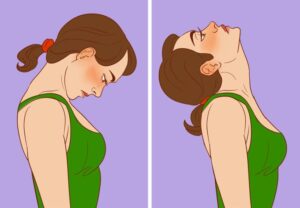
- Perform this exercise in a standing position.
- Start this exercise with your head squarely over your shoulder joint & your back straight.
- Then Lower your chin toward your chest & hold for 15 seconds.
- Relax & slowly lift your head back up.
- Then Tilt your chin up toward the ceiling & bring the base of your skull toward your back.
- Hold this position for 10 seconds & return to the start position.
- Perform the 10 times in 1 session & 3 sessions per day.
Shoulder Roll:

- Perform this exercise in a standing position.
- In the standing position Raise your shoulder joints straight & move them in a circle going forward.
- Do in the side means clockwise 6 times.
- Then return to the start position & make another side means anticlockwise 6 circles.
- Repeat this 3 times per day.

Neck Flexion (Forward Bending):
- Perform this exercise in standing & sitting positions.
- Then Gradually lower the chin toward the chest & look downward while only moving the head.
- Once time when the head is flexed forward as far as you can feel comfortable.
- Hold this exercise position for 10 seconds before returning to the neutral position.
- Perform the 10 times in 1 session & 3 sessions per day.
Lateral Neck Flexion (Bending Side to Side):
- Perform this exercise in standing & sitting positions.
- Then Slowly bend the head to one side, like by bringing the left ear toward the left shoulder joint.
- During the exercise, the shoulder & back remain till while the neck flexes laterally to the side.
- Once time when the head is flexed as far as you can feel comfortable.
- Try to hold this exercise for 10 seconds before returning the head to a neutral position.
- Perform the 10 times in 1 session & 3 sessions per day.
Neck Rotation (Turning Side to Side):
- Perform this exercise in a standing & sitting position.
- You must keep the straight back & shoulder joint.
- Then gradually turn the head to the left side as far as you can but without increasing pain.
- When your head is reached its rotation limit.
- Hold this exercise position for 10 seconds before bringing it back to the neutral position.
- Perform the 10 times in 1 session & 3 sessions per day.
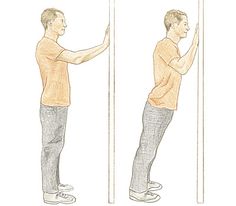
Wall Push Up:
- Start this exercise with feet approximately shoulder-width apart.
- Place the hands against the wall slightly below the shoulder joint level & elbows straight.
- Bend the elbow joint while keeping the head in a neutral position.
- Hold this exercise position for 10 seconds.
- Perform the 10 times in 1 session & 3 sessions per day.
Theraban Rows:
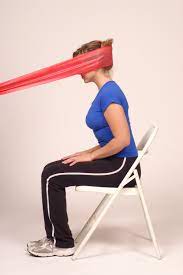
- First Place the theraband around a doorknob & tie a knot in the theraband & close it in the door.
- The band is at chest level.
- You are standing tall with each end of Theraband in your hands & knee joint slightly bent, abdominal muscles tight.
- Must be Maintained the tight trunk muscles & pull arms back while squeezing the shoulder blades together.
- You are trying to focus on squeezing the shoulder blades without shrugging the shoulder joint up towards the ears.
- Then return to starting position but Do not lean back.
- Hold this exercise position for 10 seconds.
- Perform the 10 times in 1 session & 3 sessions per day.
Prone Rows:
- You are lying on your stomach means a prone position with your arms dangling off the side of the bed.
- For comfort use a pillow under your stomach.
- Start this exercise by pulling the arms back while bending the elbow joint & squeezing the shoulders blades together then slowly returning to starting position.
- But always take care of these things do not lift your head & pulling your arms back.
- Hold this exercise position for 10 seconds.
- Perform the 10 times in 1 session & 3 sessions per day.
Behind the Back Drill:
- You are lying on facedown.
- Place both palms down on the back of your head.
- Your elbow joint pointed out to the sides.
- This is starting position of this exercise.
- Then Extend your arms in the shape of the letter Y.
- Try to Reach your arms as wide as you can & circle them down the sides of your body with palms down.
- You must keep your palms down & flip your hands over to palms up & bring your hands to the center of your lower back.
- Hold this exercise position for 10 seconds.
- Perform the 10 times in 1 session & 3 sessions per day.
Side bends:
- Extend your both arms straight above the head & clasp your hands.
- Without bending the neck try to lean slowly toward the left side.
- Return to the center & must keep the arms above the head.
- Repeat the movement on the right side.
- Hold this exercise position for 10 seconds.
- Perform the 10 times in 1 session & 3 sessions per day.
Head lifts:
- You are Lie flat on the back with the arms stretched to the sides.
- Nod the head & tuck in the chin.
- Hold this exercise for a few seconds before releasing back to a neutral position.
- Hold this exercise position for 10 seconds.
- Perform the 10 times in 1 session & 3 sessions per day.
Lateral raises:
- You are standing with the feet shoulder-width apart & weight in each hand.
- Must be Kept the body still, move the arms outward till they are level with the shoulder joint.
- Then slowly lower the arms back to the side & repeat.
- Hold this exercise position for 10 seconds.
- Perform the 10 times in 1 session & 3 sessions per day.
Anterior raises:
- You are Holding the weights in each hand & stand upright.
- Then Slowly move both weights forward & away from the body.
- Must be Keep the arms straight & keep moving till the weights are level with the shoulder joint.
- Then slowly return to the starting position.
- Hold this exercise position for 10 seconds.
- Perform the 10 times in 1 session & 3 sessions per day.
Seated overhead press:
- You are sitting on a bench or chair.
- Grip the weights in each hand level with the shoulder joints.
- Must be Push the weights upward & extend the arms overhead.
- Then slowly return the weights to the sides of the shoulder joint before repeating the motion.
- Hold this exercise position for 10 seconds.
- Perform the 10 times in 1 session & 3 sessions per day.
Rows:
- Attach a resistance band to a door handle.
- Hold the band handles in front of you.
- You are sitting on a bench & chair or standing up.
- Pull the band handles toward the lower abdomen till they are in line with the side body & the elbow joint is behind you.
- Slowly release before repeating.
- Hold this exercise position for 10 seconds.
- Perform the 10 times in 1 session & 3 sessions per day.
Neck spasms at night:
- You also experience neck spasms at night when you feel:
- When you sleep in a position which is lead to strains in your neck.
- If you use a mattress & pillow which is not providing enough support.
- If you do clench or grind your teeth during the sleeping position.
- To minimize strain on your neck & try to sleep on your back & your side instead of your stomach.
- You are using a feather & memory foam pillow which conforms to the contours of your head & neck.
- You are always using the supportive pillow but not using a too high & stiff pillow & the firm mattress also help in neck spasm.
- When you feel clenching or grinding your teeth at night you must make an appointment with your dentist.
- The dentist is recommending a mouth guard.
- This device helps protect your teeth, gums & jaw from the harmful which is apply to effects of clenching & grinding.
Neck spasms in children:
- If you spend long periods when children looking at a smartphone, computer & television.
- If the children playing sports & taking part in other physical activities.
- When the children carry a heavy backpack full of school supplies.
- If the children sleeping in an uneven position
- These mild cases of neck spasms in children are usually treated with rest, OTC pain relievers & other home remedies.
- When you suspect that your child is injured neck due to a fall & car accident while the children taking part in a contact sport & other high-impact activity so call 911 because it is a sign of spinal cord injury
- when you feel your children’s neck stiffness & a fever over 100.0°F (37.8°C) so that to children in the nearest emergency department because it is the sign of meningitis.
What is home management & first aid for neck muscle spasms?
- Over-the-counter pain relievers:
- To reduce neck pain from a neck spasm help to take an over-the-counter (OTC) pain reliever like as:
- Nnaproxen sodium (Aleve)
- Aspirin (Bufferin)
- Acetaminophen (Tylenol)
- Ibuprofen (Advil, Motrin)
- Many OTC pain which is help to relieve to ease muscle tension by reducing inflammation which is lead to worsening the pain of a neck spasm.
- Ice pack:
- Applying an ice pack & cold compress to your neck spasm area provides relief from pain mostly in the first couple of days when you experience a neck spasm.
- But don’t put ice & ice packs directly on your skin always wrap an ice pack & bag of ice in a thin cloth or towel.
- Then apply the wrapped ice to your neck spasm for a maximum of 10 minutes at a time.
- Heat therapy:
- Heat therapy is help soothe pain in your neck spasm like a warm water bottle, taking a warm shower, or pressing a warm cloth & place the heating pad on your neck spasm area.
- To avoid burns, always check the temperature before applying heat therapy to your neck. If you’re using a warm water bottle or heating pad, place a thin cloth between it and your skin. Avoid falling asleep with a heating pad on your skin.
- Light activity:
- At home, remedies rest is an important part of the recovery process, but total inactivity is rarely recommended.
- You are trying to keep moving while taking time off from strenuous activities like avoiding lifting heavy objects & twisting your neck you are doing gentle stretches & other light activities without worse the pain.
How do prevent neck muscle spasms?
- You are taken to regular screen breaks.
- You are doing the exercise regularly.
- You must use a laptop or computer stands for to adjust screen height.
- Always follow a good posture.
- Improve posture with strengthening exercises, such as pilates
- Must use supportive pillows.


